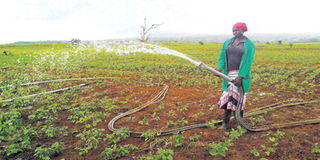Fisherfolk cast aside nets for hoes to fight hunger

Julia Awuor sprinkles water on been seedlings. The seedlings are set to be transplanted to 120-acres of land under irrigation in Asembo Bay in Siaya County. PHOTO | OWUOR OWUOR |
What you need to know:
- The land that has remained fallow for years is today covered by greens neatly grown in rows. The village-like homestead also has lush garden beds with over six types of vegetables and a chicken coop full of layers.
- The project started by three founding members today boasts of more than 3,000 members. Locals gather every week in this learning centre, not only to acquire farming skills, but also to access its unique hatchery services.
When night falls on the lakeside region of Nyanza, energetic young men and women gather their fishing gear and make their way to the waters to do what they know best — fishing.
Fishing in Lake Victoria has remained the sole source of livelihood for more than a century in this region owing to climate that do not support crop cultivation.
But with dwindling fish stocks due to over-fishing and pollution, most fisherfolk are struggling to make ends meet.
REMAINED FALLOW
This has pushed some residents of Asembo Bay in Siaya County to embrace crop farming to supplement their fish income while others have quit fishing altogether.
One of the groups now farming are Dala Rieko where a group of young men and women irrigate crops on a rocky quarter acre. The parcel is owned by the local people was set aside for training.
The land that has remained fallow for years is today covered by greens neatly grown in rows. The village-like homestead also has lush garden beds with over six types of vegetables and a chicken coop full of layers.
Five workers can be seen plucking sukuma wiki as others uproot weeds in pawpaw, beans, moringa and spinach sections of the farm.
“What we are doing is called hanging gardening (cultivating on a small farm built on, or next to, a stone wall).
“We were advised by a visiting tourist from Norway to adopt the concept on our rocky farms. It works well for us,’’ group member Andrew Menya says.
The project that was started to help impart knowledge on area residents is bearing fruit as the entire village has embraced crop farming and is slowly drifting away from fishing.
“We started small about five years ago. By then, we only had one sprinkler, but now we have 12 sprinklers. We use solar energy to pump water from the lake into reservoirs from which water flows to the farms by gravity,” Menya says.
WATER HYACINTH
The main objective of the organisation was to introduce and promote sustainable crop farming in the region, according founding member Alex Omino.
“We wanted a place where people would come to learn farming,” Omino says.
Every morning, the group uses wheelbarrows to gather water hyacinth on the lakeside to make manure for their crops.
“Once we discovered that we can make cheap compost manure using the destructive weed, we no longer buy fertiliser,” Margaret Dola, a group member, says.
The project started by three founding members today boasts of more than 3,000 members. Locals gather every week in this learning centre, not only to acquire farming skills, but also to access its unique hatchery services.
Robert Jalang’o, a poultry keeper, says the group’s nine incubators have helped him expand his chicken farming.
“I started by keeping nine layers. Using the incubators, I have managed to increase my birds to 300. It is more rewarding compared to fishing. The hatchery makes it possible for my hens to lay eggs throughout the year,” he says.
The group has six casual staff, who work on the farm in shifts.
“Whenever the eggs are brought, the first thing we probe is whether the farmer followed the recommended storage procedures.
MARKS THE EGGS
“We then do candling (passing light through the eggs) to isolate cracked eggs,” explains Florence Achieng’, a hatchery attendant.
Achieng then marks the eggs to enable individual farmers identify their eggs once they hatch.
She then leaves the eggs to cool for about four hours before putting them in the incubator.
In a week, Achieng’ says, she hatches 200 eggs. They charge farmers who follow the recommended storage procedure Sh20 per egg and Sh40 for those found to have violated the rules.
“The money realised is ploughed back (into the group kitty). Every week, we conduct training for two groups of about 15 members.
“Each member is paid a Sh300 token, but we recommend that half of the money realised from training be used to start their own projects,” says Omino.
The group aspires to transform the programme into a “Climate Smart Village” in the next five years to enable farmers in the region to effectively adapt to changing climate.




